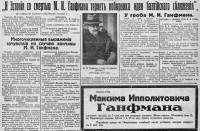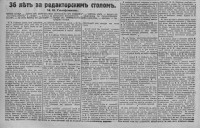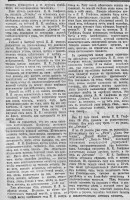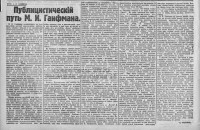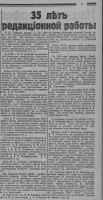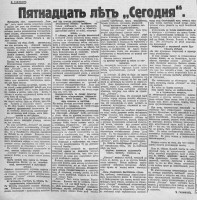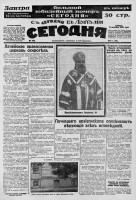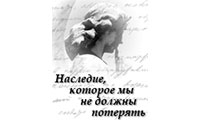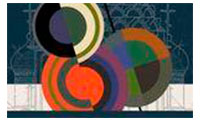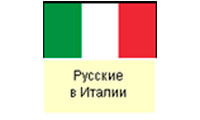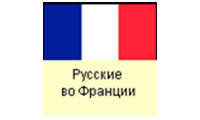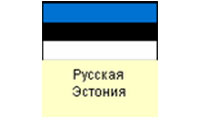Maxim Hanfmann
Maxim Hanfmann (4/16th of October 1873, Taurage, Kaunas Governorate, Russian Empire – 15th of November 1934, Riga, Republic of Latvia) – an editor of the Riga newspaper «Segodnya» from 1922 to 1934.
Maxim Hanfmann was born in a Jewish family, which resided in the village of Taurage, in the western part of Lithuania. He received elementary education in a cheder (a Jewish elementary school). Later, he graduated from a gymnazium in Šiauliai. Around that time young Hanfmann converted to Christianity. In 1891 he enrolled into the Law Faculty of the University of Saint-Petersburg. Later, he was arrested for a membership in a Marxist group and, consequently, was expelled from the university. In 1895 he resumed his studies at the University of Kazan, where became fond of journalism.
After
graduating from the University of Kazan, Hanfmann returned to Saint-Petersburg
where he started his advocacy. However, soon he was again exiled to Kazan along
with a group of progressive members of Russian intelligentsia. There he resumed
his work as a journalist. Soon Hanfmann became one of the spokesmen of liberal
Russian quarters.
After
his return to Saint-Petersburg, Hanfmann was accepted to the editorial office of
newspaper “Pravo”, where he not only had proven himself as a publicist, but also
as an expert in law. Inter alia, he raised the matter regarding the existing ban
of Lithuanian writing in the North-Western region. His arguments were so powerful,
that the Senate was forced to accept them and lifted the ban. M. Hanfmann was not
only a theorist, but was also able to masterfully implement theory in practice.
His participation in the court process regarding the Gomel Pogrom was also
quite successful.
During
the prerevolutionary era Hanfmann worked in various prominent Russian
periodicals.
However,
researchers mostly link his activities during the prerevolutionary period with newspaper
“Retch”. This periodical was established in 1906 as an official newspaper of
the Constitutional Democratic Party. Ideologically, Hanfmann was close to the Kadets,
but had never been a member of the party. He was closely connected with the
newspaper from the very moment of its establishing till it was closed by the
Bolsheviks.
In
1918 Hanfmann left Petrograd (Saint-Petersburg) and went to Kiev, where P. Milyukov
was planning to start publishing a newspaper. However, this project was not
fulfilled, so Hanfmann moved to Odessa where he started working in newspaper “Juzhnoe
slovo” (Ivan Bunin was among its editorial staff). In Odessa Hanfmann was
caught by the Soviet authorities and only in 1921, after having to face many
difficulties, he managed to return to his motherland – Lithuania, where he
immediately received citizenship and was offered to start an advocacy. However,
he chose the offer from Riga, from newspaper “Segodnya”.
Hanfmann
arrived to Riga on the 31st of December 1921, and already in the first
issue of “Segodnya” in 1922 his article in the memory of V. Korolenko – a litterateur
and a publicist, defender of rights and justice, was published.
Starting
from 1922 and till his death, Hanfmann had been an actual editor of “Segodnya”,
even though all issues were signed by Alexander Kruminsky (1876-1954), who was a
managing editor. Due to Hanfmann, “Segodnya” became one of the most popular
newspaper in the Russian community outside Russia in 1920s-1930s.
“Employment of Hanfmann in Segodnya was a considerable luck of the
publishers. It is difficult to imagine any other candidate, who would be able
to influence the formation of the image of the newspaper so significantly.” (Lazar Fleishman, Yuri Abizov, Boris
Ravdin. Russian Press in Riga: from the History of the Newspaper Segodnya in
the 1930s. Volume I. On the Verge of Epochs. Stanford, 1997, p. 54).
M.
Hanfmann’s range of interests was not limited only with journalism. He was a
member of many Russian organizations, inter alia, was a member of the board of
the Society of Russian Lawyers. He participated in the Days of Russian Culture,
admired and supported the Russian Theatre, read lectures at the Russian
Institute of University Knowledge.
Despite
health problems, Hanfmann worked almost up to his final days. His last article
was in the memory of archbishop Janis (Pommers).
Maxim
Hanfmann died in Riga on 15th of November 1934. His widely attended funeral took place on the
Pokrovsky cemetery.
It
is possible to imagine the scale of Hanfmann’s personality, the significance of
which was much broader than the borders of Latvia, through multiple responses,
which arrived after his death (in the supplement).
By Tatiana Feigmane
Family:
Spouse in the first marriage:
Jekaterina Hanfmann, born Anosova.
Spouse in the second
marriage: Jelena Hanfmann.
Children from the
first marriage:
Eugenia Hanfmann (1905, Saint-Petersburg – 1983, USA), a psychologist, a professor.
Alexander Hanfmann (1909, Saint-Petersburg – 1997, USA), an engineer.
George Hanfmann (1911, Saint-Petersburg – 1986, USA), an archaeologist, a professor.
Andrew Hanfman [with only one last “n”!]; 1912, Saint-Petersburg – not earlier than 1989, USA), a specialist in comparative literary studies; a long-time CIA operative where he, presumably, worked on sociological analysis of Soviet literary issues and samizdat; was a teacher at a college.
The article supplemented by Boris
Ravdin.
Sources of information:
Русское юридическое общество. – Сегодня, № 98, 10-04-1928;
Русские университетские курсы приступают к работе. – Сегодня, № 262, 21-09-1929.
М.И. Ганфман – десять лет в «Сегодня». – Сегодня, № 1, 01-01-1932;
Каминка А.И. Публицистический путь М.И. Ганфмана. – Сегодня, № 292, 22-10-1933;
Милюков П. Старший ученик младшему учителю. К 60-летию М.И. Ганфмана. – Сегодня, № 292, 22-10-1933;
Оречкин Бор. М.И. Ганфман – редактор «Сегодня». – Сегодня, № 292, 22-10-1933.
Яблоновский Александр. С М.И. Ганфманом в самой оригинальной газете. – Сегодня, № 292, 22-10-1933.
Чествование М.И. Ганфмана. – Сегодня, № 293, 23-10-1933;
Максим Ганфман. Латвийская православная церковь осиротела. – Сегодня, № 283, 13-10-1934;
Максим Ганфман. Пятнадцать лет «Сегодня». – Сегодня, № 283, 13-10-1934;
36 лет за редакторским столом; Похороны главного редактора «Сегодня» М.И. Ганфмана; Выражения сочувствия по случаю кончины М.И. Ганфмана. – Сегодня, № 317, 16-11-1934;
Синайский Василий. Светлой памяти М.И. Ганфмана. – Сегодня, № 317, 16-11-1934;
И Эстония со смертью М.И. Ганфмана теряет поборника идеи Балтийского сближения; У гроба М.И. Ганфмана; Многочисленные выражения сочувствия по случаю кончины М.И. Ганфмана. – Сегодня, № 318, 17-11-1934;
Прот. Н. Шалфеев. М.И. Ганфман и русская общественность. – Сегодня, № 318, 17-11-1934;
Пётр Пильский. Под стеклянным колпаком. Памяти М.И. Ганфмана. – Сегодня, № 318, 17-11-1934;
Изгоев А.С. Какой светильник разума угас! Памяти М.И. Ганфмана. – Сегодня, № 319, 18-11-1934;
Максим Лев. Жертва жестокого бога. – Сегодня, № 319, 18-11-1934;
Тело М.И. Ганфмана перевезено в Покровскую церковь. – Сегодня, № 319, 18-11-1934;
Погребение М.И. Ганфмана. – Сегодня, № 319, 19-11-1934;
Отклики на кончину М.И. Ганфмана. – Сегодня, № 321, 20-11-1934;
«Уходят старые, светоносные богатыри». Отклики на кончину М.И. Ганфмана. – Сегодня, № 323, 22-11-1934;
Перов А. Тяжёлая утрата. Светлой памяти М.И. Ганфмана. – Для Вас, № 48, 24-11-1934;
Памяти М.И. Ганфмана. – Сегодня, № 326, 25-11-1934;
Каминка А.И. М.И. Ганфман в «Речи и в «Сегодня». К сороковому дню кончины. – Сегодня, № 335, 24-12-1934;
Год без М.И. Ганфмана. – Сегодня, № 316, 15-11-1935;
Гессен В.И. Памяти друга. – Сегодня, № 316, 15-11-1935;
Вторая годовщина смерти М.И. Ганфмана. – Сегодня, № 316, 16-11-1936;
Открытие памятника на могиле М.И. Ганфмана. – Сегодня, № 148, 29-05-1938;
Лазарь Флейшман, Юрий Абызов, Борис Равдин. Русская печать в Риге: из истории газеты Сегодня 1930-х годов. Книга I. На грани эпох. – Stanford, 1997; Юрий Абызов, Борис Равдин, Лазарь Флейшман. Русская печать в Риге: из истории газеты Сегодня 1930-х годов. Книга II. Сквозь кризис. – Stanford, 1997; Борис Равдин, Лазарь Флейшман, Юрий Абызов. Русская печать в Риге: из истории газеты Сегодня 1930-х годов. Книга III. Конец демократии. – Stanford, 1997; Юрий Абызов, Лазарь Флейшман, Борис Равдин. Русская печать в Риге: из истории газеты Сегодня 1930-х годов. Книга IV. Между Гитлером и Сталиным. – Stanford, 1997; Борис Равдин, Лазарь Флейшман, Юрий Абызов. Русская печать в Риге: из истории газеты Сегодня 1930-х годов. Книга V. Близость катастрофы. Stanford, 1997;
Сергей Цоя. Русский институт университетских знаний: страницы истории. – Seminarium Hortus Humanitatis. Альманах. Выпуск XLIV. – Рига, 2016;
Максим Ипполитович Ганфман (1873-1934). – В сб. Покровское кладбище. Слава и забвение. - Рига, 2004












